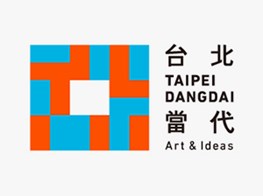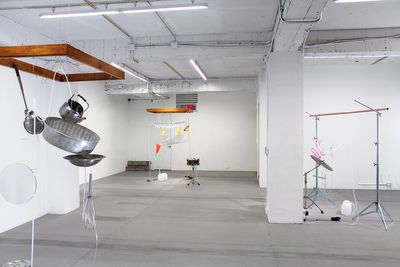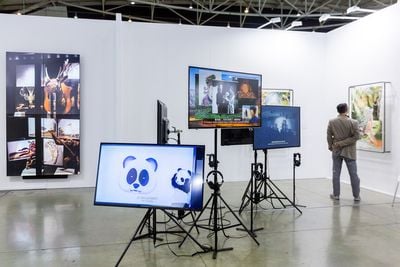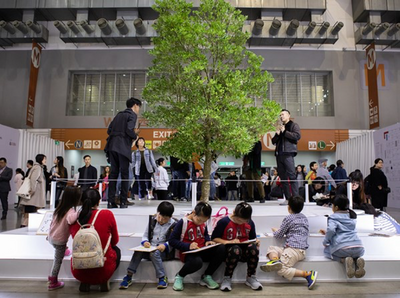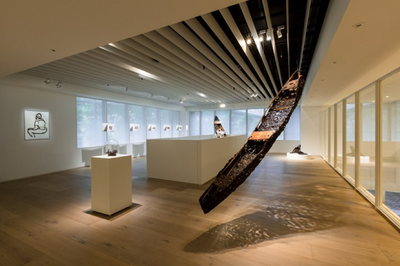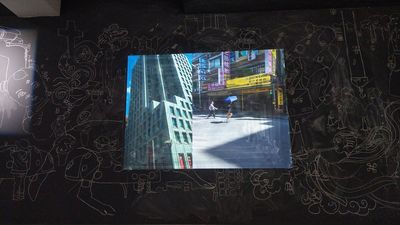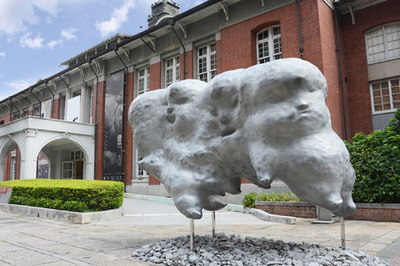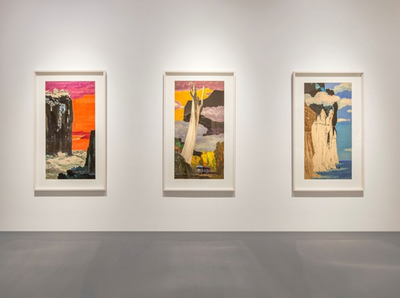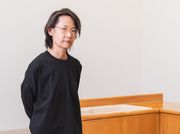Anita Huang and Jason Chi
UBS Open Classroom Series
Jason Chi and Anita Huang. Courtesy Jason Chi and Anita Huang.
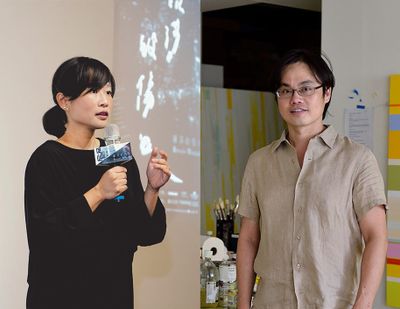
Jason Chi and Anita Huang. Courtesy Jason Chi and Anita Huang.
'We are kind of a mixture of every influence,' summarises Anita Huang, the curator of Taipei's Museum of Contemporary Art, in relation to Taiwan's art scene. The island nation, which became the seat of the Kuomintang after the political party was defeated by the Communist Party of China in 1949, just after the country's occupation by Japan between 1895 and 1945, has endured waves of influence that continue to shape its art scene. MOCA Taipei is itself a visual manifestation of this. The first institution in Taipei dedicated purely to contemporary art, the museum is housed in a Japanese colonial building that was once the Jan Cheng Elementary School. After its run as Taipei's city hall after 1945, the government instigated its transformation into a shared space as both the Jan Cheng Junior High School and a Museum of Contemporary Art.
MOCA Taipei is one amongst many varied art spaces in the city, including the Taipei Fine Arts Museum, the oldest museum dedicated to modern and contemporary art, founded in 1983; along with the National Palace Museum, which houses over 600,000 artefacts spanning 5,000 years of history. Originally founded in 1925 in Beijing, the Museum relocated to Taipei during the Chinese Civil War in 1948 to safeguard its collection. Laid upon these stones, the rest of Taipei's art spaces vary between artist-run initiatives, such as TheCubeProject Space, commercial galleries such as Eslite Gallery, Lin & Lin Gallery, Tina Keng Gallery, and Project Fulfill Art Space, and a collection of discursive platforms, including C-LAB—an 'incubator for Taiwan's contemporary culture' that was founded in 2018 in the former Air Force Command Headquarters.
Taipei is not exempt from the global wave of art fairs, either. Already hosting the annual Ink Now and Art Taipei, the city welcomed Taipei Dangdai between 18 and 20 January 2019—a new initiative by Magnus Renfrew, who established Art HK in 2008, which later morphed into Art Basel Hong Kong, also formerly under his directorship. Ninety galleries from around joined the first edition—including David Zwirner, Galerie Thaddaeus Ropac, and Kukje Gallery—which will take place once more between 17 and 19 January 2020, upon the guidance of an international Advisory Group consisting of Taiwanese and international collectors.
Artist and collector Jason Chi is one such person, who is joined by Anita Huang in this edited transcript of a talk from the UBS Open Classroom programme at Art Basel in Hong Kong earlier this year (29–31 March 2019), to discuss the key characteristics of the city's scene in light of Taipei Dangdai's recent inauguration.
Taipei already has a very established art scene, but the power of an art fair is that it brings global attention to a city's scene. In relation to Taipei Dangdai, I wondered if you could perhaps discuss how this global spotlight has affected the art scene?
Anita Huang: When Magnus Renfrew announced that he wanted to open Taipei Dangdai, we were all very excited. We know it must have had an effect on the art scene, but it is hard to tell how with just one edition of the fair. This is an interesting time for people to visit Taipei, and to see the fair and the Taipei Biennial. Some are visiting for the first time, and others are visiting after many times. And for the local art community, this is a chance to build international relationships. At MOCA, we have worked with many international visitors over the past few months and have discussed potential collaborations.
Jason Chi: After seeing the development of Art HK to Art Basel Hong Kong over the past seven years, people really see the potential in Taipei. There are many Taiwanese artists and gallerists that have travelled to Hong Kong over the past seven years, who have seen Hong Kong become an international art hub, and the third largest art market after New York and London. Hopefully, as Anita said, we will develop greater connections with the international art scene. I think that'd be great.
Within Taipei, what do you feel have been the major transformations of the last decade?
AH: I've observed the rise of a new generation, with many talented professionals who choose to stay in institutions. Before that, they preferred to be independent or teach at the universities, but recently the institutions have changed due to gradual reforms. Last year, C-LAB [Taiwan Contemporary Culture Lab] opened—they focus on cultural innovations, and attract young talent to their great new team. Also, at the Kaohsiung Museum of Fine Arts, there is a new director [Dr Yulin Lee], and they focus on the Global South, and there are more in-house curators there. All these institutions have bigger resources and better teams. I think these are exciting developments that are worth paying attention to.
AH: I've observed the rise of a new generation, with many talented professionals who choose to stay in institutions. Before that, they preferred to be independent or teach at the universities, but recently the institutions have changed due to gradual reforms. Last year, C-LAB [Taiwan Contemporary Culture Lab] opened—they focus on cultural innovations, and attract young talent to their great new team. Also, at the Kaohsiung Museum of Fine Arts, there is a new director [Dr Yulin Lee], and they focus on the Global South, and there are more in-house curators there. All these institutions have bigger resources and better teams. I think these are exciting developments that are worth paying attention to.
JC: In general, there's definitely greater awareness and appreciation for art in Taiwan. I remember growing up in Taiwan, and most parents wanted their kids to become doctors or lawyers. But now, people really appreciate art more. I think, like everything else, it starts with education. The younger generation can now explore what they want to do, and have the choice to go into design or art. We now have many more galleries in Taiwan, and last year I counted that we have at least seven art fairs. It doesn't seem like a lot, but for a small place, it's quite a bit. Besides public institutions, there are also more private museums. I'm proud to say I'm from Taichung, Taiwan, where there are really beautiful private museums. There is also Jut Art Museum in Taipei. People are really trying to build something for the future—for the next generations.
And do you feel that there are artist hubs across the different cities? You mentioned Kaohsiung and Taichung. How do other cities compare in terms of their art communities? Or do you think everything is kind of centred around Taipei?
AH: In Tainan there are very strong art communities, because of the Tainan National University of the arts. But they've developed something very different from what we can see in Taipei. They really focus on local things and develop art from the tradition of Taiwan.
JC: I live and work in Taichung, in central Taiwan, and I'm perhaps a little bit more American, so I know that group you're talking about in the south but for me, it's still much more Taipei-centric. For all the big galleries and art shows, I still go to Taipei. I'm a painter, so I really don't socialise much with anybody—I just do my own thing.
What do you feel sets the Taipei art scene apart from other hubs in the Asia-Pacific region, like Hong Kong?
AH: I think that because of Taiwan's geopolitical situations, it's very difficult to identify what Taiwanese art is. Because we have the heritage of Chinese art, and we also inherited modern art during Japanese colonisation, so there is Japanese influence. We also have very rich, indigenous art, and then there is a powerful Western influence. We are kind of a mixture of every influence. This makes us have a mixed character that is maybe not easy to identify, but it means we don't actually belong anywhere.
JC: I think diversity is really the key. Taiwan has this mix of old and new—people really respect tradition. In Taipei, we have the greatest Chinese art collection in the world, at The Palace Museum. You also have new things like MOCA. Taiwan is a place of many immigrants, from China and now Southeast Asia—Vietnam, and even Hong Kong. I think that will eventually infuse new blood and energy in Taiwan's art scene. I'm very excited about that.
Jason, you mentioned earlier that you're a recluse in your artistic practice, but I'm sure you're part of an artist community in Taipei. As an abstract painter, do you follow a certain movement of artists? Are there other artists in that community who have a similar approach to painting as you?
JC: I mean, painting comes from a line of great tradition. Oil painting has, depending on who you ask, a history of 600 to 1,000 years. I'm still learning, in a way. I love Cézanne, for example. He's probably my favourite painter, and is considered the father of modern painting. I just saw a show of his works during Art Basel Hong Kong at Gagosian, alongside Morandi and Sanyu (Cézanne, Morandi, and Sanyu, 26 March–11 May 2019). I love Morandi as well. As a painter, I have to respect tradition, but do my own thing in order to do something creative; different from the past.
Anita, in terms of curatorial practice in Taipei, I'm quite curious about the platforms that exist—specifically in education. I know that the art critic and curator Lu Pei-Yi launched the Masters in Critical and Curatorial Studies in Contemporary Arts at the Taipei National University of Education in 2016. How are programmes like these, or at institutions such as MOCA contributing to curatorial practice, or a community of curators in Taipei?
AH: Actually, it's a really new programme. We did not really have a curatorial programme before the mid-2000s. The curators that you can see are journalists, professors, or like me—I worked in a museum, and then became a curator. We are all from different backgrounds. There are some artists who have become curators. We are now starting to look back and see how curators have started in Taiwan's art scene, and then you can now there have been some evolutions since the nineties.
What can we expect from MOCA's programme in the coming years?
AH: MOCA is an institution that is flexible, and it reflects contemporary society much faster than other institutions in Taipei. I think we will continue to build up our international relationships and broaden the issues that we cover. Before, we held LGBTQ exhibitions, and last year we focused on moving image. We regularly invite international contemporary artists, such as Isaac Julien and John Akomfrah for the group exhibition, The Rebellion of Moving Image (3 March–6 May 2018), and we continue to seek out young talented Taiwanese and Indigenous artists. This year, we are launching a five-year project focusing on Taiwanese contemporary art. We are actually very open to all kinds of collaborative projects.
Jason, I understand you studied architecture at Rhode Island School of Design. How does that affect your painting practice?
JC: Well, architecture is very logical. In the early years it affected my paintings—I liked to do very geometric lines and shapes. As I get a little bit older—and hopefully wiser—I am trying to free that up. One of my favourite painters, Philip Guston, said—although I'm paraphrasing—that the artist's first job is to have freedom, and that's what I'm trying to find. I'm trying to break out from my more rigid architecture background, or as we used to call it in school, 'archi-torture'. It was a very rigid programme. Now when I paint, I try not to think too much about it.
As part of that advisory committee, what do you think are important requirements for Taipei Dangdai?
JC: This really is the first time we have all these mega-galleries coming to Taiwan, such as Hauser & Wirth, David Zwirner, and Gagosian. They bring a lot of good work that you don't see every day. I think it is an educational privilege as an art student or artist. These are works that you might only see in a museum in America, or Europe. Kids in Taiwan don't get to see that in high school. But I grew up in the States, so I was very lucky that I see that. I think this will really help art students. Local Taiwanese galleries can see how international galleries function—how they curate and display their work. And when you bring in more international collectors, hopefully they will appreciate Taiwan artists as well.
Are there any specific institutions, individuals, or artist-run platforms that MOCA collaborates with?
AH: Yes. This year we will have the Taipei Digital Art Festival, for which we will collaborate with the Association of the Visual Arts. They do this festival every year in different places. This year, they will come to MOCA, and we will collaborate with them. This is very new. We also collaborated with private foundations for the LGBTQ exhibitions.
Do you feel the Taiwanese art scene has become fuller over the past few years?
JC: I think we are moving in the right direction. Again, it all starts with education. As more people know about art, more people will appreciate it. With Taipei Dangdai, they did a really good job marketing the event. For the last day, they actually had to turn people away. I think people are really catching on.
AH: I think in Taipei there are many, many interesting things happening, but we always lack something to bring it together. For example, for Taipei Dangdai, you could see something happening amongst the galleries, but I think we still need city-wide events that everybody—museums, art spaces, and galleries—could get involved in throughout several weeks, to attract international visitors. I think that's the most important thing. —[O]


